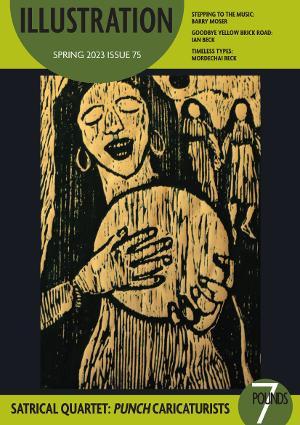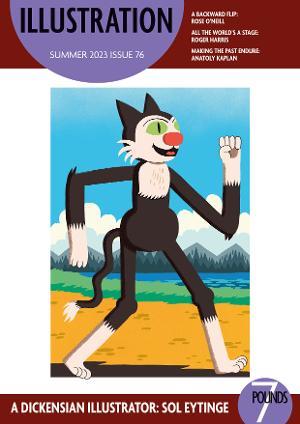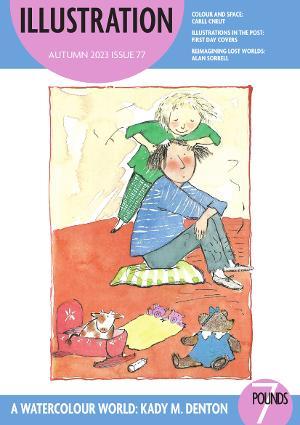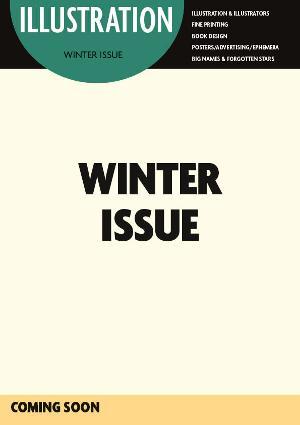
Illustration - Volume 20 - 2023
In issue 75 we’ll be focusing on some outspoken illustrators with a distinctive vision. Our opening piece is an essay by Professor Catherine Golden on Barry Moser, who is often described as the greatest living artist working in the medium of wood engraving. Catherine explores Moser’s striking interpretations of literary classics in moody black and white. In complete contrast is the print-work of Mordecai Beck. Mordecai explains his intense and moving images of biblical figures, offering a new look at traditional and timeless characters. Another Beck – Ian Archie Beck – takes us into an entirely different world as he recalls his work for Elton John’s classic 1973 album, Goodbye Yellow Brick Road, sharing original art-work as he reflects on the demands of his memorable brief. Memorable too is the art of nineteenth century satirists and commentators, and this time we get a chance to look at practitioners from both sides of the Channel. Brian MacAvera continues his series of insightful readings of French graphic artists, focusing on the astringent drawings of Jean-Louis Forain, and Dr Mark Bryant reiterates the importance of the cartoon-work of John Leech and his associates drawing in the pages of Punch as they created the traditions of pictorial satire. We also have the usual reviews, news of exhibitions and other announcements in the world of illustration.
In Illustration 76 we’ll be looking at some lesser-known artists, past and present. Professor Jo Devereaux charts the art and life of the American designer, Rose O’Neill, the inventor of the elfin figures known as “the Kewpies,” and in complete contrast are Sol Eytinge’s visualizations of Dickens. Though eclipsed by Phiz and Cruikshank, Eytinge offered some new and interesting interpretations of the great Boz; Professor Philip Allingham considers this artist as the opening number in a series of Dickensian essays. We have other distinctive voices too. Jenny Portlock takes us into the magical world of Roger Harris, whose cool, contemplative images conjure up a dream-world, both here and there, real and not-real, and Amy Hunter recounts her fascination with Richard Kennedy’s vital and evocative illustrations of everyday life in one of her favourite books, A Boy at the Hogarth Press. Far from ordinary is a Russian artist of deep feeling, Anatoly Kaplan; Mordechai Beck explains his complex achievement. And Jack Teagle completes the picture in his reflections on his own practice as an illustrator, providing many amusing but thought-provoking designs of comic-book figures such as Dennis the Menace and Dandy.
In Illustration 77 we present some wonderful illustrations for children. Our opening essay by Warren Clements is on Kady MacDonald, whose enchanting designs evoke an intense imaginative world, and we follow this up with Wilfried Onzea’s account of Carll Cneut, an illustrator with a brilliant sense of character and an unusual way of treating the spaces on the page. Moving back in time, Ruth Prickett tells us about an earlier artist for children – H. J. Ford, the creator of dream-worlds for Andrew Lang’s series of fairy books. But the adult world is never far behind. Sally Dunne reveals her creative process in her images based on character and landscape and Mordechai Beck reflects on the work of David Moss, a printmaker poised between tradition and the challenges of modern living; Dr Mark Bryant explains the cartoons and illustrations of Bernard Partridge, whose penetrating gaze anatomized social behaviour; and the Editor celebrates the “reconstruction” drawings of Alan Sorrell, an artist-cum-historian whose haunting evocations of the past breathed new life into the ruined castles of Wales. Professor Philip Allingham also continues his series on lesser-known Dickensian visualizers of the word, this time focussing on the book-art of Felix Darley.
In issue 78 we have an exciting range of essays. Professor Martin Salisbury reflects on the life and art of the celebrated illustrator, John Lawrence, who has just turned ninety. Lawrence’s designs for diverse literary texts create a strong spell, and the same is true of Peter Newell, an interpreter of Alice’s Adventures in Wonderland; Warren Clements takes us into his haunting world. Equally vibrant is the art of the contemporary illustrator, Josephine Birch. Jo talks candidly about her imagery, which varies between humorous subjects and moody landscapes. We also have a strong cast from the nineteenth century. Dr Jacqueline Banerjee considers the art of Robert Taylor Pritchett, who produced vivid illustrations of diverse locations, and Professor Philip Allingham examines the haunting work of Luke Fildes, one of Dickens’s lesser-known collaborators, and the creator of illustrations for the author’s unfinished novel, The Mystery of Edwin Drood. Brian McAvera continues his highly insightful series on French practitioners of the nineteenth century with a look at the droll commentaries of Daumier and Professor Catherine Golden completes our tour around the world – which encompasses British, French and American artists – with an essay exploring the pictures in her favourite version of the Haggadah.




